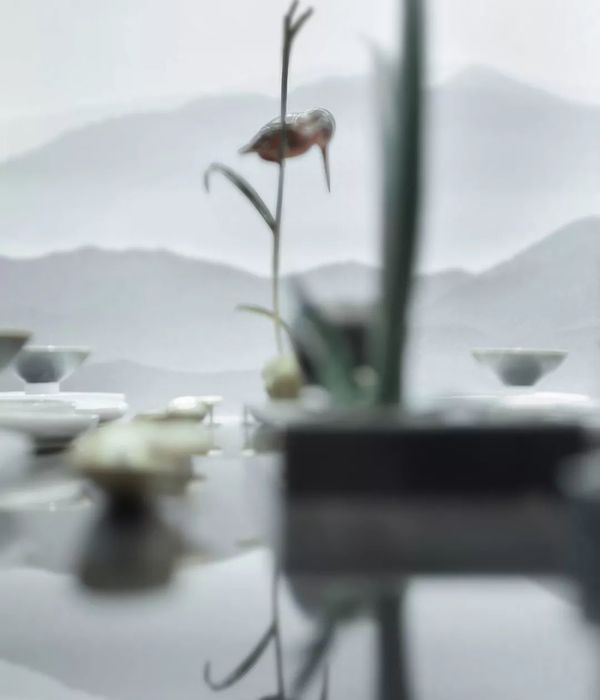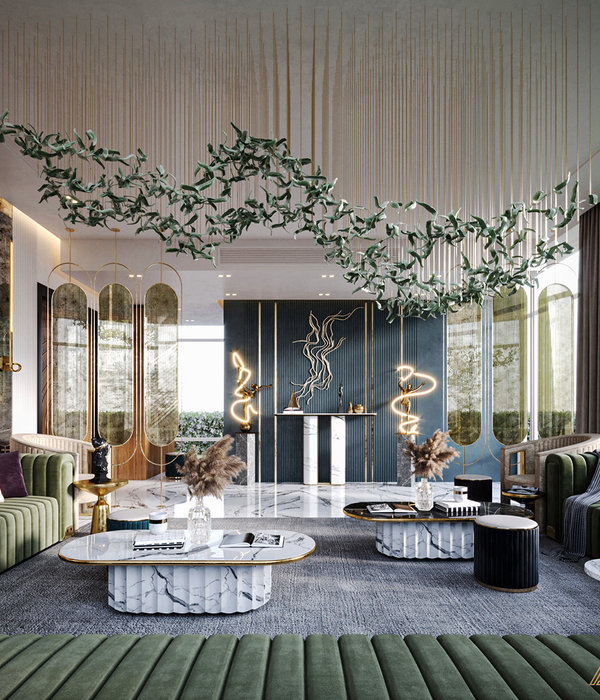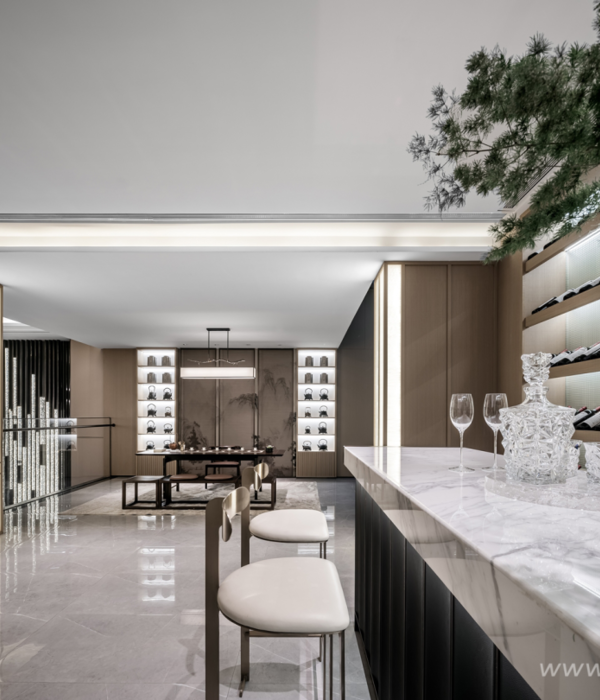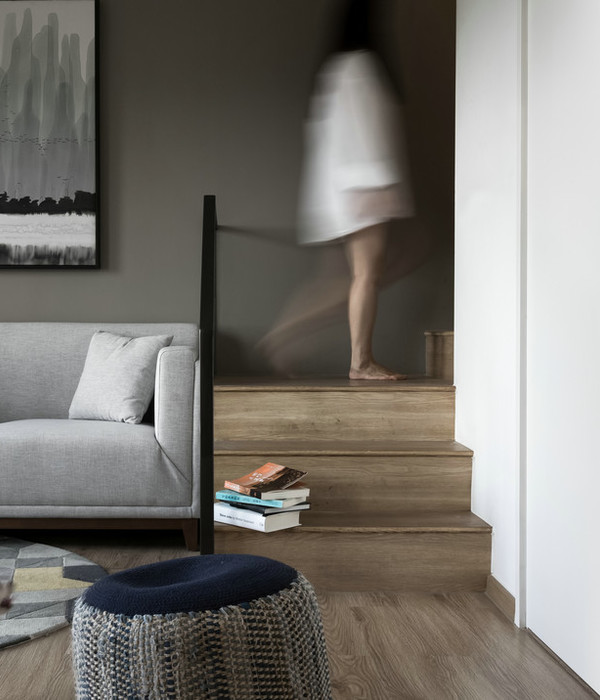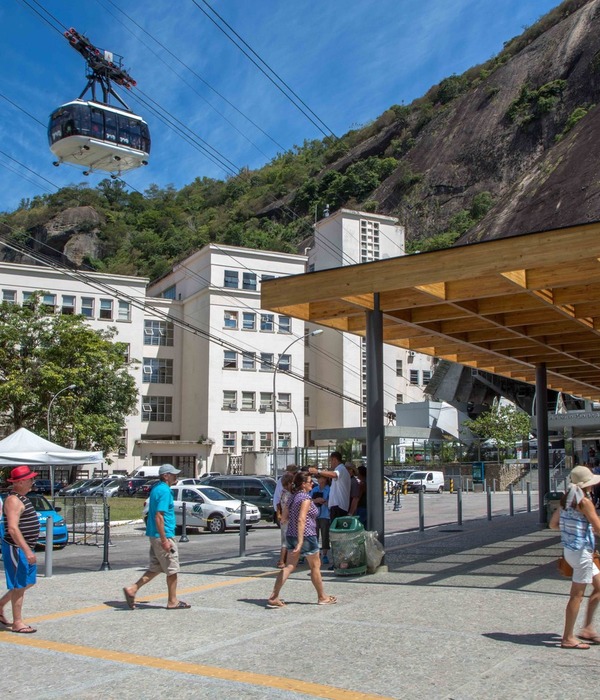该项目位于西班牙拥有900万人口,历史悠久的夏季度假胜地里瓦德奥。梯塔搭连起20米的高差地面,将滨海的路面和山上的大教堂联系起来。
梯塔主要用材为混凝土,亚光不锈钢,玻璃,以及花岗岩石材。内部有电梯和步行楼梯,外部开着不规则的洞口,方便游人在上上下下的同时观赏到外面的风景。到了晚上,梯塔在城市中静静的发出淡淡的光。这个项目其实是这个城市最高的建筑,它就像是一个不容忽视的雕塑般的里程碑,很难隐去自身的存在感。建筑师希望这个梯塔能够充分尊敬景观并且融入景观。
ACCESSIBLE RIBADEO
Connection and accessibility between the historical city center and the coast. Ribadeo. Lugo. Spain. abalo alonso architects
Ribadeo is located in the north-west of Galicia, at the border with Asturias and edging the estuary which bears its very same name. It has some nine thousand inhabitants, most of them working at the services sector. It has a protected historical quarter, a marina and a commercial port, which is strategically located in the Cantabrian coast. Within the municipality of Ribadeo lies the Catedrales beach, whose surrounding area is the second most visited place in Galicia, following Santiago de Compostela’s Cathedral. Ribadeo is a favorite summer holiday destination not just for people from the Lugo province, but also from people from every corner of Spain.
We could highlight then two outstanding features in the region: on the one hand, a consolidated population, a population with a future, and growing tourism both sporadic and regular. On the other hand, a villa swinging in between two ends: on one end, the marina and commercial port; on the other end, the historical quarter.
State of conservation and use before the project commenced.
Connecting the port to the historical quarter poses a difficult challenge: a difference in floor level of more than 20m, approaching 40m if we include the square of the city council. It turns out to be quite difficult to organize a landscape in which the two main focus of attention are in parallel plans and never intersect because they belong to different worlds. People living at the historical quarter find it difficult to get to the port. Tourists getting to the port or the marina find it difficult to get to the historical quarter. The landscape conditions lead us to a situation of total ignorance of the other world. They do not leave us any other option than overusing the car, which, under different conditions, could easily be unnecessary. In fact, historical quarters are more attractive without cars, as well as marinas.
The port follows a linear development bordering the estuary. First, the commercial port; next, the marina, and the old loading port to the end, outshined by the Santos bridge crossing the estuary at some 40m height and connecting Asturias and Galicia. Port premises, installations and facilities, and nice restaurants shape and characterize a recently established seafront promenade.
The historical quarter is organized around a large square dominated by the city council and the Moreno Tower, a modern building of extremely grand appearance but currently into disuse. In search for the sun, both buildings are turning their backs to the Cantabrian Sea and place themselves perpendicular to the estuary. They do not face the sea: it seems as if they ignored it. Or, it may be because they know there is nothing to see behind, there is nowhere to go. In fact, the area behind is a residential area stretching down to the south and not very busy. Its lack of dynamism has neglected and brought into disuse a few buildings of interest such as the old cinema, or a couple of majestic Galician urban pazos, which are currently in ruins. The connection between this and other areas, even though less sloped than between the area and the port, is also difficult, what has also contributed to its state of neglection. The development of new buildings to the south and the west worsens the current situation and reduces the chance to come up with solutions.
The problem has been put forward: improving the connections between both worlds; transforming, or using the difference in floor level as a connection hub. The city council launches a call for proposals through an ideas contest. There are no budgetary constraints. There is not a program where needs are clearly defined and specified, nor a specific location or intervention site. There is just a problem which is calling for a solution.
Design and conservation work carried out;
It is taken for granted that a straight line marks the shortest distance in between two points. However, it may not always be the optimal solution. Standard accesses bordering the Atalaya are attractive, but there is a long route. A feasible intervention would be improving the surfaces, the lighting, and limiting the traffic. However, after all, standard accesses would involve a long and deeply sloped route, so the use of the car would not be limited nor avoided, even if driving down. At some point, driving down entails driving up again, and citizens in Ribadeo are quite familiar with this situation.
Outside visitors get to the city by car, bus or boat, and the interesting thing is that they visit the port and the historical quarter. However they need a place where they can park their cars. At the historical quarter, the traffic problem is a fact. In the port area, however, the situation is different: there is more room, and the access is better. Deterrent parking lots usually work successfully under these conditions. For that reason, our proposal includes a comfortable parking lot, and limiting the use of the car at the city center. We drop the idea of intervening in the historical quarter. We explore different options involving the creation of new ways to connect the historical quarter and the port, even if it involves the installation of a mechanical transportation system. The Atalaya viewpoint becomes crucial in our project. The difference in floor level is important, but the horizontal displacement is almost inexistent. We explore three different options: conventional stairs, mechanical stairs or an elevator. The problem with conventional stairs is that nobody climbs up or down eight flights of stairs, more than a hundred steps. The layout of the ground makes even more difficult the setting of mechanical stairs. The slope, however, seems high and vertical enough for installing an elevator.
The base of the hill: almost flat. The slope runs smoothly until reaching the Atalaya viewpoint, where a few complications arise. Then, the slope becomes even gentler up to the city center. The route is indeed shorter. Then, the slope is identified as the perfect opportunity to connect the historical quarter to the port. It also becomes the best option to revitalize the area between the square and the viewpoint, which once was a marginal area: the Trinidade Street will be more transited, its shops and commercial activity revitalized and the area will become a point of interest. The three or four urban Pazos, of local interest, the old cinema and the court will be looked with different eyes.
A prism-shaped volume and four arms. Two at the bottom, two at the top. Two of them intended for entrance and exit, and two for services, each with a different orientation. At the bottom, one of the arms leads citizens to the port; another one is perpendicular to the wall, or slope. At the top, one of them leads visitors directly to the information desk: the other one, towards the ventilation area and engine room, whose access is forbidden. The central body is split in two different parts: the elevator and the stairs, the latter for maintenance and emergency reasons, or even intended for sportspeople.
At each floor at least a shaft has been pierced on different directions. The idea behind the design of the elevator, from top to bottom is: full control of the landscape towards the bridge as we enter the elevator; towards the opposite shore as we wait; towards the estuary as we start descending; half-way, a 90 degree-turn to get to the bottom, as confirmed by any momentary shaft towards the slope of the hill. We exit the elevator facing the port and after a journey travelled helicoidally. The glass at the cage of the elevator enhances views on every direction; the concrete casing qualifies it.
A glass and stainless steel prism moves up and downwards at a slower speed as usual, both to enjoy the landscape and to avoid violent flashes within the casing. At night, the elevator becomes an urban referent with its faint lighting and movement.
Lattices within the accesses facilitate the closing of the elevator area at night or at certain periods of the year, which is essential for maintenance, security and even vandalism.
Context in which the project was undertaken;
Needless to say that integrating a new item within a landscape, in this case an edging item within a protected historical area, is of utmost importance: the entrance, the exit, its connection with the surrounding area, its anchoring in the slope… All those features become transition spaces. They lead visitors and citizens into the elevator or and out of it. Large format granite tiles following bush-hammered gross treatments. Dry joints have been set transversally and open longitudinally allowing for the grass to grow and leaving space for recessed lights.
At the bottom, the floor elevates to the other side of the promenade causing the traffic to slow down and optimizing the pedestrian traffic. The measure is strengthened with the installation of prior control kerbs. Some of the granite tiles are embedded in the floor. The aim is achieving light and unbroken edges and hence, continuity. At the Atalaya viewpoint, slopes within the perimeter area have been slightly modified to enhance accessibility. Part of the wall, albeit lacking of value, has been restored to achieve an elevation at the elevator landing level, and to reduce the difference in level with the upper part. The floor pattern is similar to the one at bottom, but filled joints have been set longitudinally and dry transversally. On the edge of the viewpoint, open joints have been set, as in the lower part, allowing for the grass to grow. Finally, rows of benches complete the development works within the area, as well as the preservation of existing trees.
Design and technical problems involved and their chosen solutions both before and during the work;
Black concrete bearing walls, built-in at the base and left free at the top, including a 9 meter flight leaving us on the uppermost platform prevent us from intervening at the chapel atrium. On the outer part, the wood formwork every 10 centimeters in height is causing stretches of between 1 and 5 centimeters, the latter resembling slate walls in the surrounding area. On the inner part, smooth formwork and varnished at a later stage in search for the glitter of wet stones, resembling the way down to dungeons. Joints coinciding with stair landings have been studied. Rail shafts have been left empty, creating another suborder. Modulation every 50 centimeters, every 3 steps and every 3 meters in between landings, same heigh as the formwork elevation.
Concrete stairs and shortened steps. Separated from the walls. Light falling through both sides. Small “leds” providing built-in emergency lighting. Concrete railing and matt stainless steel hand rail.
Electrical machinery is chosen considering the difficulties to lay the foundations and build-in the piston in the foundation rock; and foreseeing the swinging of the elevator. The engine room, access to which is restricted, lies at the upper part and is also of stainless steel, as most fixtures. Its required dimensions, a bit larger than the cage shaft, result in a flight which, in shape, resembles all the other accesses. The door is treated as another piece of the jigsaw made up by the shafts. A folding stairs allows for its access in compliance with the rules and regulations. The operating hose is covered with a steel casing to avoid trouble with the wind, and it is the only closed fixture. Besides the safety items, a door has been set half way, as well as a cutting buoy at the pit and a dynamiter, in case wind speed is excessive.
Finally, matt stainless steel cage and glass walls. Inferior and superior mechanisms have both been covered to enhance the greatest design simplicity and to achieve symmetry: glass on three sides so it enables the largest viewing opportunities as it hides lift guides, wiring and doors. The information desk features the same characteristics as the elevator: steel structure, glass walls, and a small toilet. Also stainless steel doors and folding lattice frames. All in all, using the shortest number of materials as possible: concrete, matt stainless steel and glass. In the housing development, granite stone.
Response to urban or landscape context;
Our proposal has a clearly sculptural target in mind: achieving that our elevator becomes a landmark for the city, just like the Atalaya chapel or the Moreno tower. A risky but firm bet. It is obvious that once this option is chosen, one cannot go unnoticed; not because of self-praise, but because it is really difficult to “hide” an 8-floor building, actually the tallest building in Ribadeo. However, it does not necessarily mean either that one will not pay respect to the landscape, to what already exists; that one will not pay attention and to its integration within the landscape.
The elevator thus becomes a rightful aim. The profile on the other side of the estuary has a new referent, which is also noticeable from the Santos bridge, and even the port. One may even sense its presence strolling along the narrow and winding streets in the historical quarter, and reaching the Atalaya viewpoint. We seize the opportunity brought by the elevator to set a tourist information desk. The features of the landscape, and technical requirements demanded, encourage us to discard other options such as bars. It just does not seem appropriate, and in any case, there are additional areas within the city center offering better opportunities.
The slope in which the elevator is mounted is facing north; therefore it is a shadowy area. Both the top and the bottom access platforms are cleared and provide good visibility for seeing and being seen. All hints lead us towards the classic panoramic elevator. Our approach however shows subtle nuances of its own. On the one hand, we avoid any sort of glass façade to escape from reflections and from the hard image of curtain walls. Also, we build an envelope giving the elevator a volumetric shape and depth, providing varied and biased visions, contrasts. We are not searching for a direct route; our aim is not achieving the shortest, straightest way. Our aim is more achieving tours along castle battlements, or cathedral bell towers. Different, varied, mental- exercising tours, magic and enchanted tours. Momentary visions towards the outside. All but the evident, for what we already have the upper viewpoint. The material forms part of the slope, as a recovered piece of an ancient wall. Black concrete with slate texture and a natural inclination towards melting with the landscape: first, because of the color, a shadowing color. Secondly, because of the texture, a natural texture, common in the area. Glossing roofing surfaces of polished black concrete bringing back to memory old slate roofs.
Architects: abalo alonso arquitectos. Elizabeth Abalo, Gonzalo
Colaboration: Carlos Bóveda, arquitecto.
Juan A. Pérez Valcárcel, Dr. Arquitecto. Cálculo de estructuras.
Promotion: Concello de Ribadeo. Ministerio de Medio Ambiente,
Medio Rural y Marino.
Construction: Dragados. Delegado Vicente Delgado. Jefe de obra, Antón
Laxe
Photography: santos diez / bisimages
Date: 2005-2010
Materials: Concrete, steel, stone
Key words: ribadeo, spain, elevator, marina board, accessibility
MORE:
Abalo Alonso Arquitectos
。更多请至:
{{item.text_origin}}


